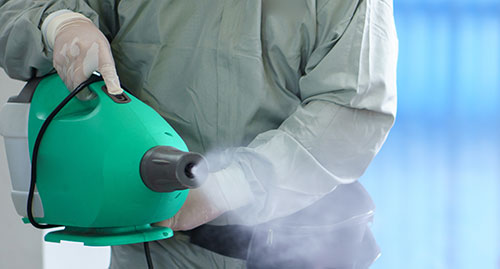Categories: Korrosjon , Rensing/rengjøring av utstyr, Bevaring og stabilisering, Ressurser
![Fogging]()
The Centers for Disease Control and Prevention (CDC) recommends surface cleaning as the most effective way to control the spread of COVID-19. Fogging disperses a disinfectant aerosol to reduce the number of airborne microorganisms and captures surfaces that are difficult to reach. Concerns regarding high-touch surfaces have become top of mind for educational institutions, manufacturing facilities, airlines and other entities who have since introduced a variety of disinfection methods, including fogging, into their classrooms, fuselages, and production spaces.
While the advantage of fogging is that it can cover a wide area in a relatively short period of time, this type of application can also quickly become the cause of future equipment breakdown. Equipment designed to be cooled with fans will draw in the airborne disinfectants, most of which contain over 90 percent water, in addition to chemicals such as hydrogen peroxide and chlorine dioxide. Sensitive electronic circuits that are not considered high touch areas will then have to contend with a great deal of water and corrosive chemicals. Introducing the fogging chemical into sensitive electronic modules will potentially shorten the lifespan of the equipment as corrosion forms. If not addressed before the corrosion causes irreversible physical damage, this will lead to partial or full equipment replacement – a costly solution.
Why is Fogging Harmful to Equipment?
Fogging presents two main issues:
- Most of the commonly used disinfectants are comprised of varying percentages of water. Fogging agents containing chlorine dioxide (CIO2), one of the more popular COVID-19 disinfecting compounds, are comprised of less than 10 percent CIO2 and over 90 percent water. This type of disinfectant is corrosive to certain metals.
A leading manufacturer of fogging machines published early on the effectiveness of their equipment, utilizing Hydrogen peroxide (H2O2) as a compound within the disinfecting solution. The safety data sheet showed that less than 13 percent of the solution consisted of H2O2 and other inert ingredients, while the remainder, over 87 percent, was deionized water. This disinfecting fogging solution, while great at killing bacteria, fungal spores and inactivating viral cells, is also a strong corroding agent when in contact with susceptible metals.
- As a result of the high water content within the various fogged chemicals, fogging increases relative humidity, which results in water on equipment that will lead to deterioration of vulnerable components.
Corrosion after a disaster event is a problem that is exacerbated with time, and fogging can constitute such an event albeit the equipment owner usually pays a third party to fog their areas of concern. As noted above, in the case of fogging, the primary concern is wet susceptible surfaces that are not only reacting to water exposure, but also the added corrosive compounds. The deterioration can be a rapid process and is caused by an electrical current that flows through a metal when water is present. When corrosion attacks printed circuit boards, it can result in electrical short circuits or lost connections, as well as resistance variation. Such deterioration can lead to failures outside of normal wear and tear.
How to Reduce Damage from Fogging
If an area containing sensitive equipment must be fogged, then precautions to protect equipment should be followed:
- Equipment should be powered off completely. This includes disconnecting uninterruptible power supplies (UPS’s), or backup systems, that will maintain some system functionality when utility power is cut off.
- Ventilation vans and cooling grids should be sealed off, or the equipment completely covered, to ensure that the disinfectant does not penetrate internal systems.
If it is not possible to power off the equipment (for example if power interruption would cause an unacceptable business income loss) or if it is not feasible to cover the equipment, fogging should not take place. Instead, hand-wiping techniques may be the better option as these methods allow for a controlled spread of the utilized disinfecting solution.
What Should be Done if Equipment was Fogged
If equipment was fogged, a restoration expert should be called in to harvest analytical wipe samples in an effort to quantify the level of introduced contaminants on the electronic circuitry. In this case, the primary contaminant is easy to identify, being the disinfectant that was used, but the amount that settled on the circuitry is important quantify for triage purposes. The probability of equipment failure increases exponentially as more corrosive contaminants are introduced. Keep in mind that fogging in many places is performed repeatedly.
Wipe samples, thus, help determine whether further steps will need to be taken. The samples will likely show exposure variation. While some items may not require any action, others will require immediate attention when compared to those that do have lower levels of exposure.
The expert will also obtain conductivity measurements in the event that the equipment owner will want to power on equipment before the analytical sample results are obtained from the lab. While this method of testing is not as comprehensive as harvested samples, it does provide some certainty regarding the likelihood of electrical short circuiting.
A quick way to slow corrosion formation is to control the environment the equipment is housed in – ventilating the area and lowering the relative humidity to below 40 percent. The precautions are similar to those taken after water exposure from a burst pipe or rain. Lowering the humidity quickly can do a lot to protect equipment from further damage. This should be done as soon as it is safe to enter the area after fogging.
If mitigation is needed, the expert will establish which decontamination process should be employed on each item to return it to pre-loss condition. As noted above, decontamination reduces both the recovery cost and the business income loss related to equipment downtime. Collaboratively working with manufacturers ensures that warranties and service contracts remain intact. When decontamination is completed correctly, contamination levels will be reduced to below the IPC J-standard threshold, which is 10.06 µg/in2 or 1.56 µg/cm2 of aggregate sodium chloride (NaCl) equivalent.
While it is best to avoid fogging areas containing technical equipment, it is not always avoidable. Precautions to protect equipment should be followed, although if the equipment has been exposed to corrosive disinfectants, AREPA can help establish whether decontamination is necessary and get your equipment back to pre-loss condition. Contact us to find out how we can help.
To learn more about this topic and earn continuing education credit*, sign up for our free webinar on March 10th.
*All of our webinars are pending approval for one hour of CE credit for Insurance Adjusters in the following states: Alabama, Alberta, British Columbia, Florida, Georgia, Indiana, Louisiana, Manitoba, Mississippi, New Hampshire, Oklahoma, Texas, Utah and Wyoming. All of our webinars are also pending approval for one PE-point through NIVRE in the Netherlands.
Please note: in order to receive continuing education credit, you must watch the live webinar in its entirety. On Demand webinars do not qualify for continuing education credits.
ABOUT THE AUTHOR
By: Jesse van Leersum

Jesse van Leersum is the Technical Operations Director based in the Netherlands and has more than 29 years of experience in the technical reconditioning industry. Within AREPA, he has held several positions where the successful restoration of technical equipment has always been his main focus and responsibility. Under his leadership, some of the most diverse claims have been carried out and successfully completed.

